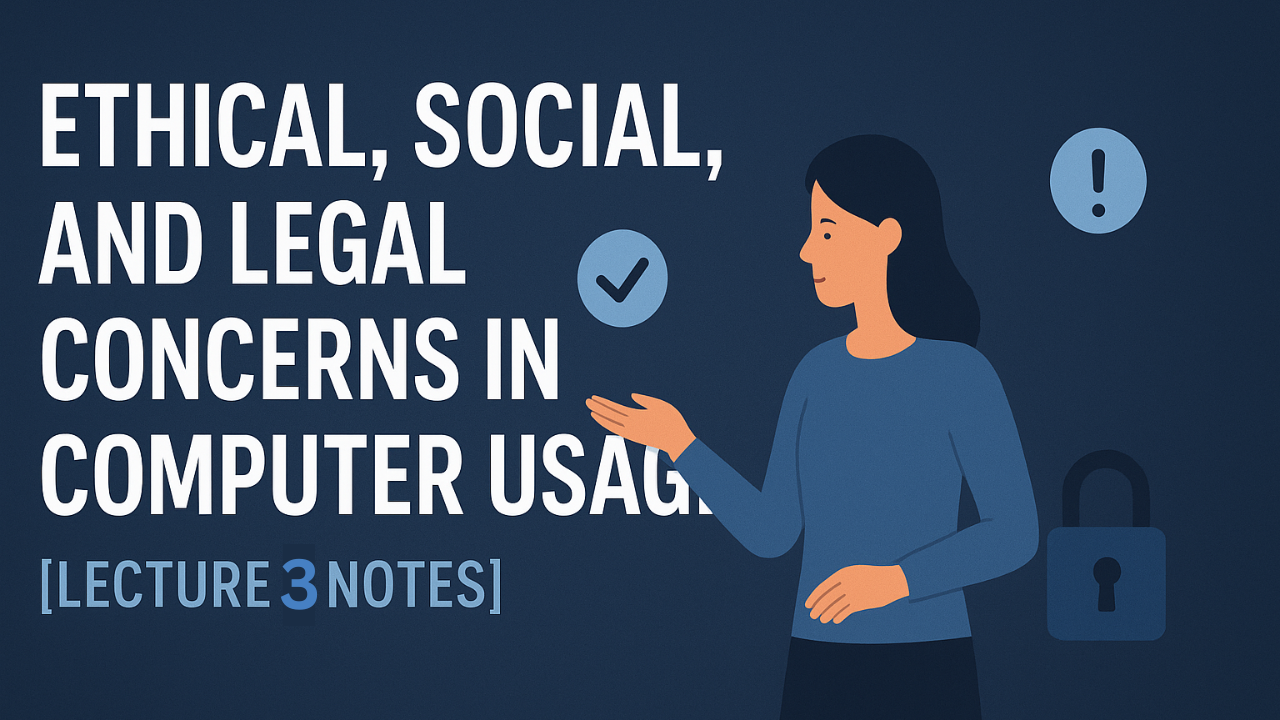Intellectual Property Rights (IPR)
Why IPR Matters
Intellectual property rights protect creative works, inventions, and ideas.
They give creators the power to decide how their work is used or shared.
Without IPR, anyone could copy or misuse someone’s work without permission.
Key Concepts of Intellectual Property
Copyright
Definition: A legal right that protects original works like books, music, movies, and software.
Example: When an author writes a novel, only they can publish or sell it unless they give permission.
Trademarks
Definition: Unique names, logos, or slogans that identify a company’s products or services.
Examples:
- Nike logo → A registered trademark.
- Apple logo → The bitten apple is Apple’s trademark.
- Coca-Cola name → The word “Coca-Cola” itself is a trademark.
- Adidas symbol → The three stripes are a trademark of Adidas.
Patents
Definition: Exclusive rights granted for new inventions or processes.
Example: A company that designs a new smartphone feature can patent it so others can’t copy it.
Ethical and Legal Responsibilities
Using someone’s work without permission is both unethical and illegal.
Examples of violations:
- Downloading pirated movies or games.
- Copying software without a license.
- Using a photo from the internet without credit.
Software Piracy
Definition: The act of copying, sharing, or using software without purchasing the proper license.
Example: Giving copies of a paid software program to friends instead of each person buying their own license.
Why It’s Wrong:
- Causes financial loss to the software developers.
- Violates copyright law and can lead to legal consequences.
- Reduces motivation for developers to create new and better software.
Responsible Internet Use
Using the internet responsibly means being aware of how our online activities can affect us and others.
Safe Data Searches & Online Research
Safe Search Techniques
- Cross-check Information – Confirm facts from multiple trusted websites.
Example: If three reliable news outlets report the same event, it’s likely accurate. - Avoid Sensational Headlines – These headlines are designed to attract attention but are usually false or misleading.
Example of a fake headline: “Lose 20 kg in 3 days!”
Avoiding Privacy Risks
- Use Private Browsing – Browsers offer Incognito or Private Mode to prevent your history from being saved. Helpful when using shared or public computers.
- Be Careful with Personal Information – Never share phone numbers, addresses, or emails on untrusted websites. Hackers and spammers may misuse your data.
- Avoid Suspicious Links – If a link looks strange or “too good to be true,” don’t click it. Such links may lead to dangerous websites that try to steal personal information or install harmful software.
Preventing Internet Addiction
What is Internet Addiction?
Definition: Spending excessive time online, harming daily life.
Signs: Difficulty stopping internet use, neglecting sleep, studies, or family time.
Example: Scrolling social media for hours instead of doing homework.
Strategies for Digital Well-being
- Set Time Limits – Example: Only 1 hour of social media per day.
- Take Regular Breaks – Rest your eyes every hour when studying online.
- Balance with Offline Activities – Play sports, read books, or spend time with friends.
- Use Helpful Apps – Screen-time trackers can remind you to take breaks.
- Protect Mental Health – If being online makes you anxious or stressed, reduce usage.
Social Networking Safety & Online Interactions
Privacy and Good Etiquette
- Adjust Privacy Settings – Example: Make your Instagram or Facebook account private.
- Avoid posting personal details like addresses or phone numbers.
- Practice Online Manners – Be polite, avoid arguments, and don’t spread rumors.
Dealing with Cyberbullying
- Recognize It – Cyberbullying includes mean comments, rumors, or posting private photos.
- Report and Block – Social media apps allow you to block bullies and report abuse.
- Support Victims – Encourage or stand up for someone being bullied online.
- Show Respect – Treat others online the same way you’d treat them in real life.
Multiple Choice Questions (MCQs)
1. Which of the following is protected by copyright?
- A) Company logos
- B) New inventions
- C) Books and music
- D) Slogans
Answer: C) Books and music
2. What does a trademark protect?
- A) Original software code
- B) Company’s name, logo, or slogan
- C) Patented technology
- D) Academic research papers
Answer: B) Company’s name, logo, or slogan
3. Software piracy means:
- A) Buying licensed software
- B) Copying and sharing software without permission
- C) Using software for business purposes
- D) Developing new software
Answer: B) Copying and sharing software without permission
4. Which of the following is a sign of internet addiction?
- A) Balanced study and playtime
- B) Difficulty stopping internet use
- C) Using screen-time trackers
- D) Taking regular breaks
Answer: B) Difficulty stopping internet use
5. Cyberbullying includes:
- A) Posting positive comments
- B) Supporting victims
- C) Spreading online rumors
- D) Adjusting privacy settings
Answer: C) Spreading online rumors
Extra Points for Students
- Role of IPR in Education: Schools and universities encourage originality in assignments to teach students about respecting intellectual property.
- IPR in Business: Startups and entrepreneurs use trademarks and patents to protect their ideas and gain a competitive edge.
- International Protection: Intellectual property laws differ across countries, but global agreements like WIPO help maintain uniform protection.
- Digital Content Creation: YouTubers, bloggers, and influencers rely on copyright to protect videos, images, and written content from being stolen.
- Ethics in Technology: Ethical internet use includes respecting licenses, avoiding plagiarism, and citing proper references in projects or research.
- Impact on Innovation: Strong IPR laws encourage people to invent new technologies, write books, or design creative art without fear of theft.
